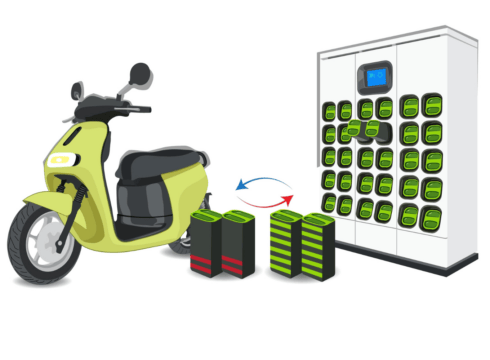Projections indicate that EV penetration could exceed 40% by 2030, driven by strong adoption in the two-wheeler (2W) and three-wheeler (3W) categories
Battery swapping and conventional charging infrastructure are two solutions being evaluated for their potential to accelerate EV adoption in India
Battery swapping consists of exchanging a depleted battery for a fully charged one at specialised swapping stations
Inc42 Daily Brief
Stay Ahead With Daily News & Analysis on India’s Tech & Startup Economy
India is on the brink of a major transformation in its transportation sector, with electric vehicles (EVs) poised to play a crucial role in reducing pollution and dependence on fossil fuels. However, widespread adoption of EVs faces significant hurdles, primarily concerning battery charging and replacement infrastructure.
Two prominent solutions—battery swapping and conventional charging infrastructure—are being evaluated for their potential to accelerate EV adoption in India. Understanding these approaches and their implications can provide valuable insights into the future of India’s electric mobility.
The Present State Of Electric Vehicle Adoption In India
According to the Bain and Company report of 2023, India’s electric vehicle (EV) market is at a pivotal juncture, with EVs currently making up about 5% of total vehicle sales between October 2022 and September 2023.
Projections indicate that EV penetration could exceed 40% by 2030, driven by strong adoption in the two-wheeler (2W) and three-wheeler (3W) categories, where rates are above 45%. This shift is expected to transform the Indian automotive market, with EVs potentially capturing over 40% of the market and generating more than $100 Bn in revenue by 2030.
Government initiatives like the Faster Adoption and Manufacturing of Hybrid and Electric Vehicles (FAME) scheme and the National Electric Mobility Mission Plan (NEMMP) underscore India’s commitment to accelerating EV adoption. Nevertheless, progress remains slow due to high upfront costs, limited vehicle range, and inadequate charging infrastructure. As a result, India’s EV density remains relatively low compared to global leaders, highlighting the urgent need for innovative solutions to overcome these barriers.
Battery Swapping: A Promising Alternative
Battery swapping consists of exchanging a depleted battery for a fully charged one at specialised swapping stations. This model offers several advantages over traditional charging methods, particularly in the context of India’s unique needs:
- Reduced Downtime: Battery swapping can significantly reduce vehicle downtime. Traditional charging can take anywhere from 30 minutes to several hours, depending on the charger and battery capacity. In contrast, swapping a battery typically takes less than five minutes, allowing drivers to quickly get back on the road. This is particularly beneficial for commercial EV fleets such as taxis and delivery vehicles, where downtime can directly impact business operations.
- Less Infrastructure Demands: Setting up battery swapping stations might require less investment compared to establishing a widespread network of high-speed charging stations. Each swapping station would need to stock a range of batteries and manage their charging, but this could be more manageable than ensuring that every public and private charging location is equipped with fast chargers.
- Reduced Charging Time and Flexibility: With swapping, the challenge of long charging times is effectively mitigated. Users can simply replace their battery and continue their journey, making it an attractive option for users who need to minimise wait times.
Challenges Of Battery Swapping
Despite its advantages, battery swapping presents several challenges:
- Standardisation: For battery swapping to be effective, a standardised battery design is necessary. This requires collaboration among manufacturers, which may be challenging in a diverse market with numerous players.
- Initial Costs: The setup of swapping stations and inventory management can be costly. Moreover, there are concerns about the maintenance and lifespan of the batteries used in swapping systems.
Charging Infrastructure: The Conventional Approach
Charging infrastruture remains the most widely adopted method for supporting EVs. It involves installing charging stations where EVs can be plugged in and charged over a period of time. This approach offers several advantages:
- Infrastructure Development: The development of a robust charging infrastructure can cater to various types of EVs and is not limited to specific battery models. With ongoing advancements, charging times are gradually decreasing, making this a more flexible solution in the long run.
- Ease of Integration: Charging stations can be integrated into existing infrastructure, such as parking lots, residential areas, and commercial spaces, making it relatively straightforward to scale up as EV adoption increases.
- Government Support: Many government policies and incentives are focused on expanding the charging infrastructure, including subsidies for setting up charging stations and regulations to support their installation.
Challenges of Charging Infrastructure
However, charging infrastructure also faces hurdles:
- High Costs: The installation of charging stations, especially fast chargers, can be expensive. Additionally, maintaining and upgrading the network to keep pace with technological advancements adds to the costs.
- Range Anxiety: Despite improvements, range anxiety remains a concern for many potential EV buyers. The perception of limited charging points, particularly in rural and underserved areas, can deter adoption.
- Grid Capacity: Increased use of electric vehicles could put additional pressure on the electricity grid, requiring significant upgrades to support widespread EV charging.
Conclusion
Both battery swapping and traditional charging infrastructure have the potential to accelerate EV adoption in India, but they address different needs and challenges. Battery swapping offers a quick and efficient solution for high-usage scenarios while charging infrastructure provides a scalable and universally compatible approach.
For India to achieve its EV adoption goals, a hybrid strategy that leverages the strengths of both methods may be the most effective way forward. Strategic investments, policy support, and technological advancements will be key in ensuring that both approaches complement each other, driving the country towards a cleaner, more sustainable future.
{{#name}}{{name}}{{/name}}{{^name}}-{{/name}}
{{#description}}{{description}}...{{/description}}{{^description}}-{{/description}}
Note: We at Inc42 take our ethics very seriously. More information about it can be found here.


